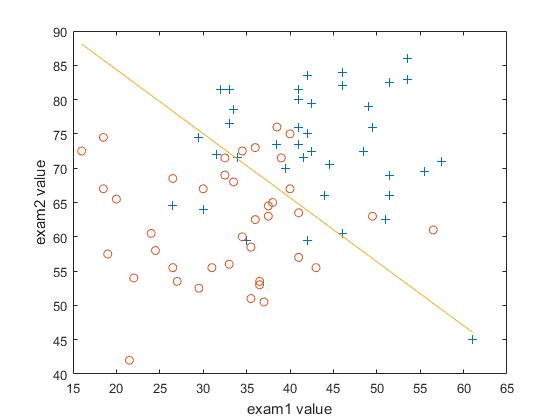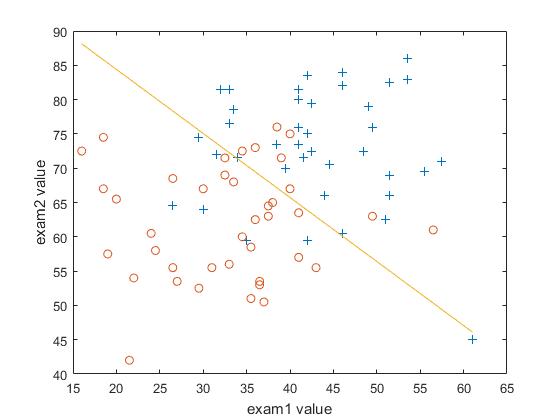版权声明:欢迎转载和交流。 https://blog.csdn.net/Hachi_Lin/article/details/86647476
1.梯度下降法
x = load('ex2x.dat');
y = load('ex2y.dat');
m = length(y);
xx = x;
mu = mean(x);
sigma = std(x);
x = (x - mean(x))./std(x); %数据标准化
x = [ones(m,1),x] ; xx = [ones(m,1),xx] ;
% find返回满足指定条件的行的索引
pos = find ( y == 1 ) ; neg = find ( y == 0 );
plot (xx( pos , 2 ),xx( pos , 3 ),'+');
hold on;
plot (xx( neg , 2 ),xx( neg , 3 ),'o');
xlabel('exam1 value');
ylabel('exam2 value');
MaxIter = 1500;
theta = zeros(size(x(1,:)))'; %初始化theta
e = 1e-6;
alpha = 0.08;
g = @(z) 1./(1+exp(-z)); %定义sigmoid函数
for i = 1:MaxIter
z = x * theta;
h = g(z); %逻辑回归模型
L_theta(i,1) = -(1/m)*sum(y.*log(h)+(1-y).*log(1-h)); %极大对数似然函数
delta_L = (1/m)*x'*(h-y); %计算梯度
%更新 L 和 theta
if (i > 1) && (abs(L_theta(i,1) - L_theta(i-1,1)) <= e)
break;
end
theta = theta - alpha*delta_L;
store(i,:) = [theta',L_theta(i,1)];
end
%画出决策边界,因为数据是标准化后的,因此需要还原回去
x_axis = x(:,2)*sigma(1) + mu(1);
y_axis = (-theta(1,1).*x(:,1) - theta(2,1).*x(:,2))/theta(3,1);
y_axis = y_axis*sigma(2) + mu(2);
plot(x_axis, y_axis,'-');
figure;
plot(1:i-1,store,'-');
legend('\theta_0','\theta_1','\theta_2','L{(\theta)}');
xlabel('iter value');
ylabel('value');
- 假设 。实现收很慢敛需要多少次迭代?注意,梯度下降算法收敛速度,可能需要很长时间才能达到最小值。
答:610次
- 收敛后得到的 值是多少?
- 计算每次迭代过程中的 和说明 在梯度下降算法中如何减少。

- 收敛之后,使用 的值找出分类问题的决策边界。

- 测试1的成绩为20分和测试2为80分的学生不被录取的概率是多少?
不被录取的概率为
先对 进行标准化
最终得到成绩1为20成绩2为80不被录取的概率为
2. 牛顿法
x = load('ex2x.dat');
y = load('ex2y.dat');
m = length(y);
mu = mean(x);
xx = x;
sigma = std(x);
x = (x - mean(x))./std(x);
x = [ones(m,1),x] ;
n = size(x,2);
% find返回满足指定条件的行的索引
pos = find ( y == 1 ) ; neg = find ( y == 0 ) ;
plot ( xx ( pos , 1 ) , xx ( pos , 2 ) , '+' ) ;
hold on
plot ( xx ( neg , 1 ) , xx ( neg , 2 ) , ' o ' )
xlabel('exam1 value');
ylabel('exam2 value');
MaxIter = 1500;
theta = zeros(size(x(1,:)))';
e = 1e-6;
H = zeros(n,n);
g = @(x) 1./(1+exp(-x));
for i = 1:MaxIter
z = x * theta;
h = g(z); %logistic model
L_theta(i,1) = -(1/m)*sum(y.*log(h)+(1-y).*log(1-h)); %log likelihood function
delta_L = (1/m)*x'*(h-y); %calculate gradient
%calculate Hessian matrix
H = (1/m).*x' * diag(h) * diag(1-h) * x;
%update L and theta
if (i > 1) && (abs(L_theta(i,1) - L_theta(i-1,1)) <= e )
break;
end
theta = theta - H^(-1)*delta_L;
store(i,:) = [theta',L_theta(i,1)];
end
x_axis = x(:,2)*sigma(1) + mu(1);
y_axis = (-theta(1,1).*x(:,1) - theta(2,1).*x(:,2))/theta(3,1);
y_axis = y_axis*sigma(2) + mu(2);
plot(x_axis, y_axis,'-');
figure
plot(1:i-1,store,'-');
legend('\theta_0','\theta_1','\theta_2','L{(\theta)}');
xlabel('iter value');
ylabel('value');
- 当收敛时 的值是多少?
- 显示牛顿法中 是如何减少的?

- 画出决策边界

- 测试1的成绩为20分和测试2为80分的学生不被录取的概率是多少?
不被录取的概率为
先对 进行标准化
最终得到成绩1为20成绩2为80不被录取的概率为
- 对比梯度下降法和牛顿法,你学到了什么?
(1)牛顿法:是通过求解目标函数的一阶导数为0时的参数,进而求出目标函数最小值时的参数。
优点:收敛速度很快,而且不需要知道学习率。
海森矩阵的逆在迭代过程中不断减小,可以起到逐步减小步长的效果。
缺点:海森矩阵的逆计算复杂,代价比较大,因此有了拟牛顿法。
(2)梯度下降法:是通过梯度方向和步长,直接求解目标函数的最小值时的参数。
越接近最优值时,步长应该不断减小,否则会在最优值附近来回震荡。
优点:计算简单,实现容易。
缺点:收敛速度比较慢,数据量大还会导致内存不足。